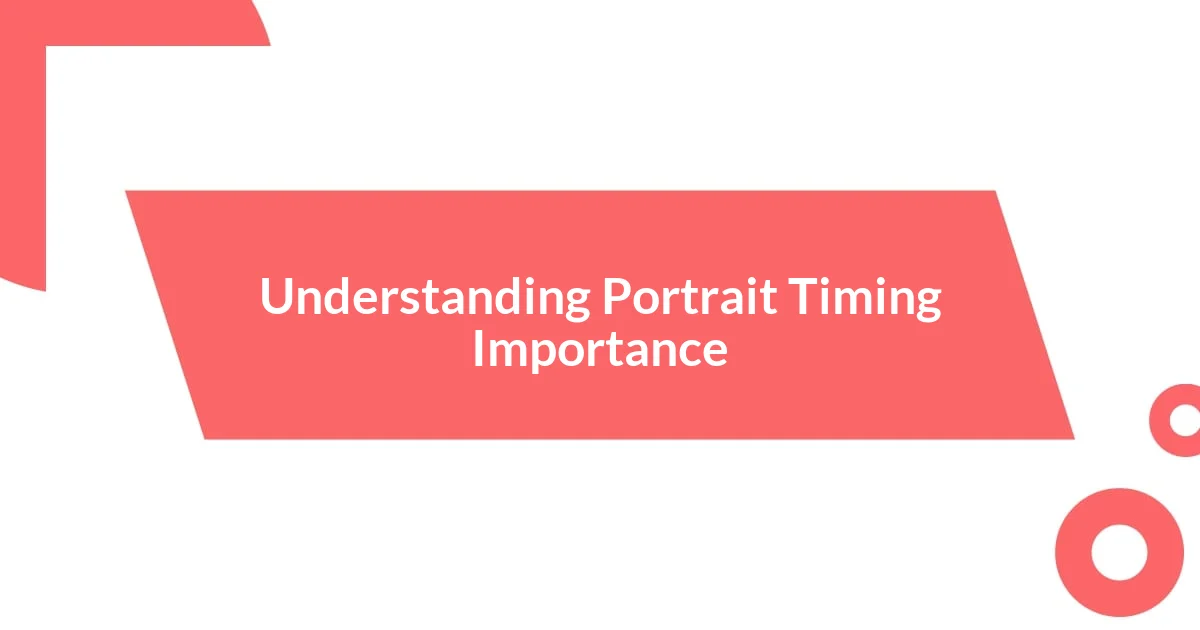Key takeaways:
- Plan portrait timing well in advance to reduce stress and maximize emotional capture, especially during optimal lighting conditions like golden hour.
- Create a detailed portrait schedule that includes travel time, aligns with other vendors, and remains flexible for unexpected events.
- Communicate openly with your photographer and bridal party to ensure everyone is aligned, fostering teamwork and maximizing genuine moments during the session.

Understanding Portrait Timing Importance
When it comes to portrait timing, I really can’t emphasize enough how vital it is to plan ahead. I remember a wedding where the couple hadn’t allocated enough time for portraits, and I could see the stress on their faces as they rushed through shots. It made me wonder: how can anyone truly enjoy their big day when they’re constantly glancing at the clock?
Timing isn’t just about the clock; it’s about capturing emotion. I once shot a wedding where we timed the portraits during that dreamy golden hour just before sunset. The warm glow not only created stunning images but also allowed the couple to savor those quiet moments together. Isn’t it amazing how just a bit of foresight can enhance those precious memories?
Another thing I’ve learned is that unexpected delays can throw off even the best-laid plans. On one occasion, a late caterer meant we had to quickly adjust portrait timing, which resulted in missing out on some prime light. This taught me the importance of flexibility in planning. So, how do you envision your photography timeline? Taking the time to think through these moments can save you stress and lead to beautiful results.

Planning Your Portrait Schedule
I’ve found that creating a detailed portrait schedule is essential for a smooth photography experience. When I work with couples, I urge them to consider the lighting conditions at different times of the day. For instance, I once had a couple who initially wanted to do portraits right after the ceremony. However, we realized that the harsh midday sun would cast unflattering shadows. By rescheduling for later in the afternoon, we captured beautiful, soft-lit images that perfectly showcased their joy and love.
To help you create a successful portrait schedule, keep these key points in mind:
- Allocate Enough Time: Plan for at least 30 to 45 minutes for individual, couple, and family portraits.
- Consider the Light: Identify the best times for natural light; golden hour can yield breathtaking results.
- Factor in Travel Time: If your portrait locations are away from the venue, account for travel time to stay on track.
- Communicate with Vendors: Keep your timeline aligned with other vendors to avoid interruptions or delays.
- Be Flexible: Leave room for adjustments due to unexpected events, and embrace the spontaneity that a wedding day brings.
By planning ahead while remaining adaptable, you can ensure that your portrait session captures the essence of your big day without any stress.

Coordinating with Your Photographer
Coordinating with your photographer is more than just scheduling; it’s about establishing a partnership. I remember a wedding where the couple and the photographer had a quick chat the night before. They discussed the couple’s must-have shots, and believe me, that simple conversation made a world of difference. It fostered trust and communication, allowing everyone to be on the same page during the whirlwind of the day.
When you meet with your photographer, don’t hesitate to share your vision. I once worked with a bride who had a specific nostalgic location in mind. We discussed how the timing of the sun would affect the shots, and I could see her excitement grow as she envisioned that perfect moment. It’s those personal touches that lead to remarkable images that truly reflect your story.
Finally, think about the flow of your day. Consider coordinating with your photographer about key moments like the first look or family gatherings. On another occasion, the family portraits were done right before dinner, and the energy was palpable—it was such a vibrant moment! This synchronization not only maximizes your time but also captures the essence of your celebration beautifully.
| Timing Aspect | Importance |
|---|---|
| Communication | Helps align expectations and desires |
| Location Timing | Maximizes natural light for stunning images |

Incorporating Venue Considerations
When it comes to incorporating venue considerations into your portrait schedule, understanding your space is crucial. I once photographed a wedding at a charming vineyard. At first glance, the rolling hills were breathtaking, but I quickly noticed that the main reception area was quite dim in the late afternoon. By discussing this with the couple early on, we adjusted our portrait timing to take advantage of the stunning outdoor scenery before the sun dipped too low. Wouldn’t you want your venue’s unique features to shine in your photos?
Additionally, think about the different settings within your venue. During another wedding at a beach resort, the couple wanted portraits along the shoreline, but we had to factor in the timing of the tides. The last thing you want is to get stuck in the sand with camera equipment or miss a golden light moment because of rising waves. That day taught me the importance of knowing the venue’s natural elements—planning around them makes all the difference in capturing those perfect shots.
Finally, consider how the atmosphere of your venue can influence your portrait session. I recall a couple who wed in a historic building filled with beautiful architecture. The couple was so excited to incorporate the unique backdrop into their portraits. By timing our session to coincide with the soft ambient light filtering through large windows, we created a magical photoshoot that reflected their love story beautifully. Isn’t it exhilarating to envision how your venue can set the tone for your memories?

Communicating with Your Bridal Party
Communicating with your bridal party is fundamental to ensuring a seamless wedding day. I remember a time when the bride took the initiative to create a group chat weeks before the wedding. It wasn’t just for logistics; she sent inspirational pictures and playful reminders of the fun we’d have. That simple act of connection made everyone feel involved, turning the bridal party into an excited team ready to support her.
When the big day approached, I found that reinforcing communication was essential. In one instance, a bride had assigned a specific role to each member of her bridal party. They had all met for coffee, discussing schedules and what to expect during the portraits. It became apparent how much easier it was for me to direct them on the day. It sparked a sense of camaraderie, making the entire experience feel more organized and enjoyable.
I often encourage brides to share their vision openly. For example, a bride expressed her desire for candid moments with her closest friends. By conveying this to her bridal party beforehand, they felt more at ease, leading to genuine laughter and joy during our session. Isn’t it wonderful how open dialogue can transform posed pictures into treasured memories that capture real emotions?

Final Tips for Successful Portraits
Preparing for wedding portraits can be an exhilarating experience, but timing is everything. I once worked with a couple who had their hearts set on golden hour shots—the soft, warm light just before sunset. We coordinated our timeline meticulously, allowing ample space for portraits, and as the sun began to dip, the magic unfolded. There’s something mesmerizing about the way natural light dances around couples, creating images that radiate love and warmth. Have you considered how crucial the timing of natural light can be for your own portraits?
Another vital aspect is taking breaks during the session. I’ve seen how fatigue can set in, especially for large bridal parties. At one wedding, we took scheduled breather moments—allowing everyone to hydrate and relax—for a very good reason. It turned out to be a game-changer! Those short, relaxed intervals led to candid laughter and heartfelt interactions, making our portraits feel alive and unposed. How do you envision incorporating natural moments to reflect your genuine connections?
Lastly, don’t forget to embrace spontaneity. During a shoot last summer, we were blessed with a surprise rain shower. Instead of retreating, the couple decided to grab an umbrella and dance in the rain. The result? An unforgettable series of portraits filled with joy and authenticity. So, I encourage brides to keep an open mind. What unexpected moments might turn into your most cherished memories? Embracing the unexpected can lead to beautifully unique portraits that truly reflect your love story.















